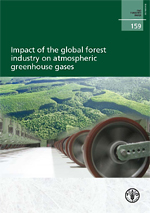 June 2010: The UN Food and Agriculture Organization (FAO) has released a forestry paper titled “Impact of the global forest industry on atmospheric greenhouse gases (GHGs),” which traces the value chain of forest products (roundwood, processed wood products, and pulp and paper) and calculates a net contribution of 467 million tons of carbon dioxide equivalent per year from the forest product chain.Authored by Reid Miner, the forestry paper estimates that the total GHG emissions from the forest products value chain are 890 million tonnes of carbon dioxide equivalent per year, and that 424 million tons of carbon dioxide equivalent are sequestered throughout the chain. It notes that the pulp and paper industry produces generally higher emissions and sequesters less carbon than other wood products sectors. The paper reviews the role of forests in sequestering and storing carbon, and describes manufacturing-related emissions, including those from primary manufacturing and final product manufacturing, as well as from management of mill wastes and purchased electricity. It then traces emissions throughout the value chain, from cradle-to-gate and gate-to-grave, and looks at emissions avoided elsewhere in society due to forest industry activities (for example, reduced methane emissions from diverting recovered paper products from landfills). The author then discusses the potential for forest-based materials to displace fossil fuels, and the findings of the Intergovernmental Panel on Climate Change (IPCC) on the mitigation potential of forests. [FAO Forestry Paper 159]
June 2010: The UN Food and Agriculture Organization (FAO) has released a forestry paper titled “Impact of the global forest industry on atmospheric greenhouse gases (GHGs),” which traces the value chain of forest products (roundwood, processed wood products, and pulp and paper) and calculates a net contribution of 467 million tons of carbon dioxide equivalent per year from the forest product chain.Authored by Reid Miner, the forestry paper estimates that the total GHG emissions from the forest products value chain are 890 million tonnes of carbon dioxide equivalent per year, and that 424 million tons of carbon dioxide equivalent are sequestered throughout the chain. It notes that the pulp and paper industry produces generally higher emissions and sequesters less carbon than other wood products sectors. The paper reviews the role of forests in sequestering and storing carbon, and describes manufacturing-related emissions, including those from primary manufacturing and final product manufacturing, as well as from management of mill wastes and purchased electricity. It then traces emissions throughout the value chain, from cradle-to-gate and gate-to-grave, and looks at emissions avoided elsewhere in society due to forest industry activities (for example, reduced methane emissions from diverting recovered paper products from landfills). The author then discusses the potential for forest-based materials to displace fossil fuels, and the findings of the Intergovernmental Panel on Climate Change (IPCC) on the mitigation potential of forests. [FAO Forestry Paper 159]
FAO Releases Study on Forestry's Impact on GHGs
